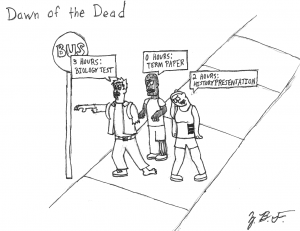
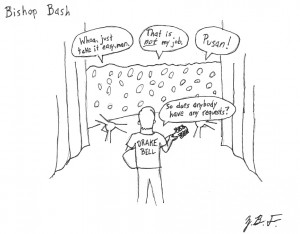
By: Gopika Nair, Transcript correspondent
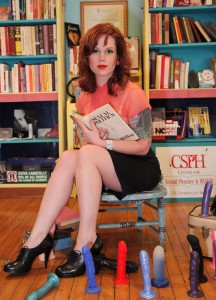
It isn’t every day that Ohio Wesleyan students walk into Bishop Cafe to find silicone-based condoms, lubricant and an assortment of sex toys lying scattered on the tables.
Curious glances, suppressed smiles and bold jokes was the popular attitude of the crowd until Megan Andelloux, the person who instructed that the objects be kept there took to the stage.
A clinical sexologist and certified sexuality educator, Andelloux witnesses such student responses regularly and she is on a mission to break some taboos.
Andelloux, the founder of the Center for Sexual Pleasure and Health, visited OWU on Tuesday, March 24 to give a talk titled, “Purring into Pleasure: Exploring Female Desires and Orgasms.” Extra seating arrangements had to be made to accommodate all the students in attendance.
Andelloux has an effortless and charming manner about her that put the audience at ease. It is not difficult to understand why.
She said that the center was created when she realized that people had a lot of questions about sex, but there wasn’t a platform that could address their concerns.
Andelloux said that talking about sex can awkward and uncomfortable, but discussing it is important.
“I don’t think people talk about it in intelligent manners,” she said. “I think that we snicker about it.”
Andelloux’s own upbringing was conservative, raised in Cape Cod, Massachusetts. She said it took her parents nine years to accept her career choice, but they are supportive now. In fact, six years ago, her mother protested for sex workers’ safety and healthcare, and this happened only by talking openly about sex.
Addressing the students, Andelloux said, “Today, you’re going to hear me say things like ‘clit owner’ and ‘penis owner’ because not everyone who has a clit identifies as female and not everyone who has a penis identifies as male.” Her words earned finger snaps from the audience.
She covered topics ranging from orgasm techniques to butt play in a frank and engaging manner. While discussing sex, she was inclusive of all genders.
Andelloux talked about embracing sex and dispelling the negativity surrounding sex. She also set out to help the audience understand that everyone’s bodies are different.
“It’s important to feel safe in our bodies,” she said. “I think that we’re taught to fear our bodies instead of rejoicing them.”
Her candid, no-nonsense approach eased the seeming disquiet that had prevailed initially, and the students responded to her constant encouragement to ask questions. She also offered prizes from the collection of sex toys to those who did.
An attendee at the talk, freshman Alanna Easley, said that it helped her learn more about sex. Having attended a Catholic school, she was taught that abstinence is good.
“Women are portrayed in media in a certain way,” Easley said, “but [talks like Andelloux’s] help people realize that that’s not what they are and that’s not what they’ll ever be. We should accept that and learn to be comfortable with our bodies.”
Freshman Mel Fizdale said the talk helped her further understand the difference between consensual sex and nonconsensual sex.
Earlier during the interview, Andelloux said that one of the reasons she is proud of her career choice is because she has helped sexual assault victims learn to love their bodies.
On their way out, students hovered by the tables with the sexual goodies, and excitedly rummaged through them.
Those were free samples from Andelloux. Greater still in value will be the sense of freedom she gave to the students to discuss topics often considered taboo.
By: Matt Cohen and Ben Miller
We went into Bishop Bash with skepticism like most people on campus. After reading the Yik-Yak feed, hearing the bad reputation of Drake Bell and looking at the lack of Instagram followers of Liberty Deep Down, how could we not have some doubts?
Let us first start by saying Liberty Deep Down was amazing. The band most OWU students had never heard of rocked Gordon Field House this past Saturday night. Not only were the members of the band fun to talk to and easy to work with, they were also great performers with a lot of energy and passion.
Many students shrugged off the event with no questions asked because of the headliner Drake Bell and the unknown band Liberty Deep Down. This was the wrong move.
As fans of music and talent, the way they performed on stage was much appreciated and impressive. We can definitely see these guys making it big time one day. And we’ll be able to say that line everyone loves hearing: “we saw them before they were famous.” Where as you’ll be disappointed of your ignorance of Bishop Bash and music. You call yourself a fan of music? Please.
Being skeptical of Bishop Bash is one thing, but not going because you think you’re too cool is crazy. The band Liberty Deep Down that OWU provided was good. They took over the stage and energized the crowd. Just because we didn’t get Cage the Elephant or Beyoncé doesn’t mean you should not have gone.
The point we are trying to get across is if you weren’t at the concert on Saturday, you really missed out on Liberty Deep Down. Any music fan would have enjoyed their performance.
P.S. If the band is looking for some PR reps for this summer’s tour, we are available.
By: Campbell Scribner
I recently reread an essay by a friend of mine, a teacher and pastor, with whom I have kept in touch since college. Actually, not a teacher or a pastor: he quit both jobs a long time ago. They felt fake, he said, rote and repetitive and hollow. So he became a freelance writer.
He wrote the essay, and I first read it, in a climate of fear and uncertainty. The United States was engaged in irresponsible, possibly illegal military actions, and we had mutual friends getting involved (a little over their heads) with the peace movement. Corporate scandals led to a series of financial shocks, one of which cost my father his job. The liberal circles in which we moved were becoming increasingly uncomfortable with the conditions under which their food and clothing were produced, leading to heated arguments about what counted as “organic” or “fair trade.” My friend stopped eating sugar for a while.
He touched on all this in his essay, but the real focus was the precarious fate of young people as they entered the workforce. Finding employment required shameless self-promotion, he complained, if not outright dishonesty. And for what? So that one could earn a living exploiting others and performing pointless tasks, laboring (as he so floridly put it) under a “harness of routine and obsequiousness.”
It was no wonder that so many college graduates had grown cynical, shielding themselves with irony and rolling their eyes at any sort of idealism. The world was built on lying, cheating, and shopping, all of which the rising generation cruelly mocked but engaged in anyway, because they didn’t feel like they could change anything. The most noble of them might pursue academic careers (as I later did) but they would have to subsist on debt and charity, and even then would feel guilty for enjoying a level of success denied to others who were equally qualified. There was no way out. It seemed that we were all doomed to the moral corruption of adulthood.
Despite all of its hand-wringing, however, the essay ended with a hopeful image: young men and women not yet beholden to the capitalist system, free from the chains of consumption that constrained Western society. The term “Arab Spring” did not yet exist—and my friend abhorred both religious orthodoxy and political violence—but he spoke approvingly of the fervor and faith with which young Muslims had reshaped the Arab world. A similar group of American youths, willing to sacrifice financial gain for more moral, meaningful work, might radically transform our own country, he wrote, renewing protections for women, children, workers, and the elderly while establishing a robust sense of the common good.
That message inspired me. It didn’t matter that Ralph Waldo Emerson and I were of different backgrounds, or that his essay, “Man the Reformer,” first appeared in 1841. We were wrestling with the same questions about the individual’s place in the modern world, and I considered him a friend.
I do not mention all of this so that you will go and read Emerson’s essay (though you should), but instead to offer some advice for study at OWU. One of the benefits of a liberal arts education is the ability to recognize that others have confronted the same quandaries and challenges that you do, albeit in times and places that may seem remote. Whether you pursue history, literature, or some other discipline, remember that learning is most effective when it captures the immediacy and applicability—the moral stakes—of other people’s experiences. Making that connection can lead to the best kind of companionship.
Campbell Scribner is an education professor whose teaching-related interests include the history and philosophy of education and the history of childhood.
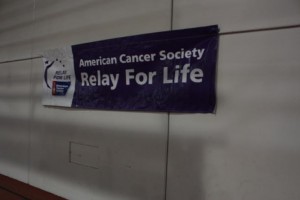
Participants at Relay for Life walked to remember those with cancer while dressed as comic book superheroes.
The annual overnight event sponsored by Colleges Against Cancer, was held on March 20 to March 21. Teams are formed and the members participate in different events throughout the night. The participants stay up all night, or as long as they can, taking laps around the track and doing different activities.
Sophomore Shaaref A. Shah, one of the presidents of Colleges Against Cancer, stated “weeks before Relay for Life, Colleges Against Cancer began promoting the event through social media.” The members of CAC sent out emails to teachers, alumni, and everyone else affiliated with Ohio Wesleyan that might want to participate.
One thing that made this year’s Relay for Life event different from year’s past is the theme. After the teams were established, CAC held meetings with the team captains to think of fundraising ideas, which was where the superhero theme was established.
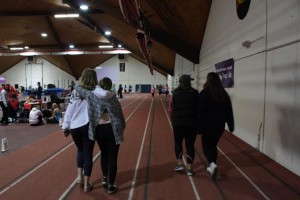
The goal this year was to raise a minimum of $15,000 to donate to American Cancer Society. The proceeds have not been counted in its entirety yet, but as of publication, OWU raised $14,000.
“My mom had cancer so I wanted to be here to support her,” sophomore Rick Gordon said. “That is my main reason.”
Fellow sophomore Claire O’Keeffe added “Relay for Life is important to me because I have lost family members to cancer in the past years and recently. Also, I thought it would be fun to come and walk around with my friends”.
Colleges Against Cancer meets every Wednesday at 5:00 pm in Hamilton-Williams Campus Center.
By: Breanne Reilly, Transcript correspondent
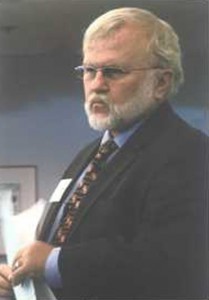
Extreme interpretations of Islam are to blame for the conflicts in the Middle East, said R. Blake Michael, professor of religion at Ohio Wesleyan University.
He opened his Great Decisions presentation Friday with a Sunni phrase about Shi’as.
“Oh Sunni of Bahrain, we know nothing of what they do is in any way related to Islam and is full of superstitions and empty turbans. There is no Islamic basis to their actions,” Michael said.
Bahrain, located in the Persian Gulf, is divided between two major denominations of Islam, the Sunni and the Shi’as. In Bahrain, the ruling family is Sunni and the population is mostly Shi’a. The quote Michael used demonstrates one of the conflicts that makes the Middle East violent because of the variety of ethno-linguistic groups and religions that reside there. Sectarianism, discrimination or hatred arising from attaching importance to perceived differences between subdivisions within a group is often the result.
To demonstrate the problem, Michael compared two maps, one depicted ethno-linguistic groups and the other depicted religions in the area. He over-laid the two maps to demonstrate how the various ethno-linguistic groups and the religions bleed into one another. This is considered problematic because the groups disagree on how their religions are interpreted.
“In Islam, the prescriptive use is the prevalent use,” Michael said. “They tend to identify their way of being Islamic as true Islam and other ways as un-Islamic.”
Like al-Qaida, ISIS pushes for a strict application of the Quran. However, while al-Qaida focused on terrorism abroad, until recently, ISIS wanted authority over territory in the Middle East because it would give its caliphate power. Now, ISIS wants recognition for off-site events. This week, it claimed responsibility for the Yemen mosque bombings and Tunisia museum attack.
With regard to those attacks, Michael recommended not forming a prejudice.
“Don’t blame that on the Muslim living down the street from you,” Michael said.
When Delaware resident Helmut Kremling asked why young people are joining ISIS, Michael explained that the appeal lies with the groups’ identification with a goal.
“It’s the same reason our military recruits are 18 years old,” Michael said. “You’re young; you’re looking for a meaning, self-definition or purpose.”
Michael said ISIS recruits identify with a radical eschatological vision that promises paradise to devotees after Armageddon.
“Better that the battle be fought and lost, than the battle not be fought,” Michael said.
As for U.S. involvement, Michael said he is no political expert, but it would be unwise for the U.S. to engage in direct conflict with ISIS.
“It would be playing right into their hands,” he said.
A survey of those attending the presentation found 84 percent opposed sending ground troops to fight ISIS if air strikes are not enough to stop the group. And 90 percent said Muslims are like people everywhere and common ground can be found. The vast majority said they believed violent conflict between civilizations is not inevitable.
“The only hope for the Middle East is that the fanaticism wears down,” Michael said.
The final session of the eight-part Great Decisions series occurs on March 27 at noon when Irfan Nooruddin, a professor in the School of Foreign Service at Georgetown University, will talk about India.
By: Ben Miller and Matt Cohen

Just like us, you’ve probably been celebrating St. Patrick’s Day your whole life. And even though you’re not quite sure why it’s a holiday, dressing like leprechauns, pinching people and day-drinking is more than enough to jump on the Patty’s bandwagon.
But just with anything else, no one likes fair-weather fans. Listen up to gain some St. Patty’s cred for this year’s festivities.
What you should know:
Saint Patrick’s Day, or the Feast of Saint Patrick, commemorates the arrival of Christianity in Ireland and Saint Patrick himself. The holiday always falls on March 17, the day Saint Patrick died. Apparently he was a pretty cool dude.

He was born in the fourth century to a wealthy family in Roman Britain. He was kidnapped at the age of 16 by Irish raiders and taken as a slave to Gaelic Ireland. Just imagine that for a second. Irish raiders! Well, turns out he spent six years with the raiders, found God and went back home where he became a priest and converted Irish pagans to Christianity.
There you have it, a little more about the exciting day.
What you need to know:
In my book, Saint Patty’s day represents the coming of spring. Believe it or not, the weather is warming up, grass is visible and the sun is kind of shining. Enjoy the day outside drinking liquids and soaking up the rays of sun. Just like Patty would have wanted.
Green beer tastes the same as normal beer. The dyed liquid is a festive treat and before long you will found out the only addition to the colored beer is that your mouth will be dyed as well. You’ll look like one big Saint Patty’s day monstah that likes those green marshmallows from Lucky Charms a little too much.

If you’re like us, green is not a prominent color of your existing wardrobe. The last minute $5 Walmart purchase is always an option. That is, if you want to be wearing the same corny shirt as three other guys at the same party as you (You don’t want that, trust us). Instead, get a plain green shirt and come up with your own St. Patty’s Day slogan to write on.
Disclaimer: If you’re stumped with coming up with any good original slogans like we are right now, let us know, maybe we can help each other out. And we’re supposed to be the writers. I know, right?
So, we think you are now ready to have a great Saint Patrick’s Day. Go make your bro Patrick proud. And always remember: Keep calm and leprechaun. We’re hilarious.
By: TC Brown
By many measures, this winter has been a pain in areas where the sun rarely reaches.
Dreadful weather is bad enough on its own, but it can also be a real boon for the radical element that deny the existence of climate change.
The cold, snow and ice morph into a convenient prop for these folks and their head-in-the-sand outlook that says changes in climate are not fueled by the world’s booming population and the ever increasing numbers of people driving fuel-burning vehicles.
Forget that in 2013 a United Nations panel, which includes thousands of scientists from around the world, said it is a 95 percent certainty that humans are the “dominant cause” behind the monumental changes to our climate.
They’re not alone. NASA, the National Academy of Sciences, the U.S. Department of Defense, the American Association for the Advancement of Science and the American Meteorological Society agree, as noted recently in The Columbus Dispatch.
Scientists seem unequivocal in their reasoning, so who’s to argue?
Send in the clowns.
At the end of February, Sen. James Inhofe, an Oklahoma Republican and well-known denier, packed snow into a large ball and lugged it into the Senate chambers. “Do you know what this is? It’s a snowball,” Inhofe said.
Not getting anything past this Congress.
Inhofe explained he had made the snowball outside and that it was very cold, “very unseasonable.” Really? Snow in February, who knew.
There’s more. Earlier this month employees of Florida’s Department of Environmental Protection revealed that they are forbidden to use phrases like “global warming” and “climate change” in official communications.
Soon after that news broke a former staffer from the Pennsylvania Department of Conservation and Natural Resources said they had been “explicitly ordered” to remove all references to climate change from the organization’s website.
And the North Carolina Department of Environment and Natural Resources also deleted links and documents related to climate change from its website. Not to be outdone, 39 Republican U.S. senators opposed an amendment that blamed human activity for climate shifts.
Playing politics with this somber and factual meteorological phenomena is a very dangerous game. Last year, that same U.N. panel of global scientists issued a report that said greenhouse gas emissions are the highest in history. The gasses come from a variety of sources, especially from the burning of fossil fuels for electricity, heat and transportation, and can trap and hold heat in the atmosphere. Globally, the ten hottest years on record have occurred since 1998.
In 2008, I spent six months helping climate change scientists develop multimedia content for their website. Frankly, I was startled by what I learned and that was seven years ago.
Glaciers and ice packs in mountain regions are in full retreat. Melting ice is expected to contribute to a continuing rise in sea levels, threatening many costal cities and potentially displacing millions. Global sea levels rose a little more than 6 ½ inches in the last century and the rate in the last decade is nearly double that, according to NASA. Small Pacific islands are sinking.
The changing climate is likely to fuel more violent and costly storms, create regional droughts and threaten the natural habitat of animal and plant life. The Nature Conservancy predicts that if the changes continue to occur rapidly, one-fourth of Earth’s species could be headed toward extinction by 2050.
Superstorm Sandy, which plowed into New Jersey in 2012, cost at least $65 billion in damages, making it the second most costly storm since Katrina wiped out the New Orleans region, according to the National Oceanic and Atmospheric Administration.
Sobering stuff, but that’s simply a big-picture scan of the potential danger and damage. Deeper evidence abounds should one look, and I strongly urge the students on this campus to get engaged.
The deniers like to claim that this is all a liberal media hoax and that little if any proof exists. Guess what drives that view? Money.
It will cost many industries real cash to clean up and reduce carbon emissions and many of those organizations and their political allies have said, “No thanks, not enough proof.”
Helen Keller, the deaf and blind author, political activist and lecturer once said, “The only thing worse than being blind is having sight but not vision.”
The scientific jury is still out on whether it is too late for us to do anything to reverse these processes. It’s clear we all need to at least try. But this country, in fact the entire planet, needs vision regarding climate change and how we as a human race might diminish these looming dangers. Politically motivated denial simply digs a deeper hole for everyone.
I’ve heard the denier’s arguments that the changes now underway have occurred on the Earth before. Certainly true, but the planet was not home to 7 billion people at the time. That’s where the dangers lie.
It’s going to take personal and even global energy to try to turn the direction in which we are headed. It’s a vital calling, if for nothing else, one simple fact – the wellbeing of future generations. It’s time to stop the political gamesmanship and act.
If we don’t, the kids will pay the real price.
TC Brown is an adjunct instructor of journalism at Ohio Wesleyan, an author, and a journalist of 25 years. His work has been featured in many publications, including The New York Times and Cleveland’s The Plain Dealer.